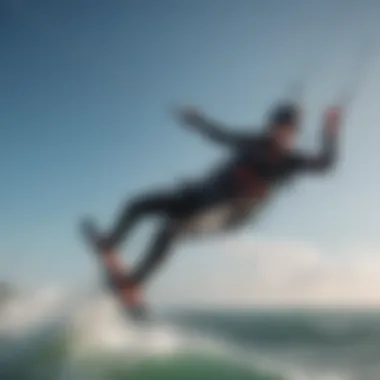Understanding Air Straps: Elevate Your Kitesurfing Game


Intro
Air straps in kitesurfing and kiteboarding serve a pivotal role, influencing both performance and professionalism on the water. Understanding these components provides surfers, whether beginners or seasoned pros, with better control, comfort, and safety as they navigate various water conditions.
Within this article, we will deconstruct the integral aspects of air straps, assessing their types and features, as well as the science fuelling their designs. This includes comparing air straps to alternative equipment options and discussing the latest advancements made in the technology surrounding them.
Ultimately, this guide aims to equip practitioners in the kitesurfing community with critical insights for making informed choices, whether selecting new equipment or maintaining current setups. Readers can expect to explore practical tips in navigating air strap technology, thus enhancing their overall kitesurfing experience.
Equipment Reviews
Kites
Modern kites have evolved significantly. Designers prioritize performance while taking kitesurfers’ needs into account. Key aspects include:
- Kite Shapes: Delta, C-shaped, and hybrid designs play distinct roles in maneuverability.
- Sizes: Options typically range from 5 to 18 meters, affecting wind conditions.
- Materials: Advanced fabrics improve efficiency and durability.
- Popular Brands: Cabrinha, Liquid Force, and Naish lead the market with innovative models.
Boards
Board selection greatly impacts kitesurfing style and execution. Different designs appeal to varying and specific techniques:
- Twintip Boards: Suited for beginner interventions, they lean towards versatility in conditions.
- Directional Boards: Feature a distinct construction ideal for surf-style riding.
- Riding Style Suitability: Choices must align with rider skill and preferred techniques—freestyle or wave riding.
Accessories
Though often overlooked, accessories enhance performance in essential ways. Each plays a role in the overall kitesurfing experience:
- Harnesses: Vital for maximizing comfort and energy efficiency.
- Lines: Proper line types can improve kite response.
- Pumps: Efficient pumping systems reduce setup time, freeing energy for riding.
- Safety Gear: Essential for injury prevention and programmed recovery plans.
Safety Guidelines
The thrill of kitesurfing ages from exhilaration to some hazards. Adhering to safety guidelines remains paramount. Riders must thoroughly understand weather interactions, observe forecasts, remain current in procedural awareness, and routinely conduct equipment checks.
Intro to Air Straps
Air straps are crucial components in the kitesurfing and kiteboarding industry. They serve not only a performance-related role but also significantly enhance rider comfort. Understanding air straps is essential as they contribute to stability and control while engaging in this high-octane sport.
Kitesurfers and kiteboarders rely on these straps to maintain a secure connection with the boarding equipment. This goes beyond mere convenience, addressing concerns about safety and comfort during each ride. Employing proper air straps can impact how a rider interacts with waves or maneuvers through different conditions. Thus, familiarity with the types he can choose from helps in avoiding discomfort and accidents.
Expanding on this, the following sections will clarify what air straps are and analyze their role in kitesurfing specifically. Delving into these details will also illustrate the considerations riders should keep in mind regarding strap selection and usage.
What Are Air Straps?
Air straps are specialized attachments affixed to kitesurfing boards. Their primary function is to secure the rider's feet onto the board. These straps can range from simple designs to more advanced forms intended for heightned performance.
The design of air straps usually involves a combination of rubber or nylon material for flexibility and resistance to wear. The thickness varies depending on brand and purpose, providing a mix of grip and comfort. Air straps often come padded or cushioned, which adds an extr layer of comfort during listing or jumping maneuvers. They connect through different types of fasteners that allow for easy adjustments according to user preferences.
The Role of Air Straps in Kitesurfing
Air straps play a vital role in ensuring a kitesurfer's control over the board. Properly adjusted air straps help maintain optimal balance between rider and equipment. When navigating in stronger winds or performing complex maneuvers, a connection with the board becomes essential. Air straps support this connection, translating movements from the rider into effective performance on the water.
Moreover, the specific seat of the air straps helps secure the rider against sudden impacts caused by waves or abrupt directions. This enables riders to fully utilize their strength and ability during tricks and jumps. Properly selected and adjusted straps aid greatly in reducing the risk of injuries.
Choosing the right air strap crucially influences both performance and safety.
It is also worth noting that the proper installation and setup of air straps is paramount for optimal performance. Over time, understanding the importance of air straps can lead to an enhancement of overall kitesurfing experience, bringing improvements at every skill level. Thus, diving deeper into the types of air straps available will lead to necessary insights for both beginners and experienced enthusiasts alike.


Types of Air Straps
Air straps are essential components in kitesurfing and kiteboarding, determining not only the rider's comfort but also their overall performance on the water. Selecting the appropriate type of air strap can enhance maneuverability and control. The crucial factors include adjusting the fit, cushioning during impacts, and integration with the board. Understanding the various types of air straps allows practitioners to make informed decisions tailored to their riding style.
Standard Air Straps
Standard air straps are basically the most traditional form of strap used in kitesurfing. They typically consist of simple designs that offer a stable connection between the rider's feet and the board. The basic cushioning offers limited shock absorption. However, they do excel in being lightweight and cost-effective, making them favorable for beginner riders. These straps are usually made of durable materials like nylon or polyester, providing basic functionality without advanced features.
The simplicity of the standard air strap stands out in its adaptability. Users may upgrade to more advanced straps as their skills develop. Ended for leisure riding, they are often praised for their reliability and solid grip. However, lack of adjustability is sometimes problematic for those exploring different styles in changing conditions.
Adjustable Air Straps
Adjustable air straps present more versatility than their standard counterparts. With enhanced features, adjustable straps allow riders to customize their fit according to individual preference. The fixation points are established in varying positions, giving you room to tweak how tightly the strap holds your foot. This extraordinary ability to cater to various foot sizes, shapes, and riding conditions bears significant benefits.
The adjustment process is usually straightforward, enabling faster transitions on the water. For example, when transitioning from flat-water parks to choppy ocean waves, multiple adjustments can provide instant relief and control without the tedious task of changing gear. Adjustable air straps also ensure the comfort needed during extended sessions.
Cushioned Air Straps
Cushioned air straps emphasize rider comfort through increased padding and shock absorbency. Designed to minimize fatigue, these straps can absorb more impact during jumps and rough rides, lessening the potential stress on the feet and joints. Having sufficient cushioning is vital for performance, allowing the rider to maintain focus and energy.
The distinguishing factor of cushioned air straps is the material used. Many brands leverage foam combinations to reduce chatter and provide a soft landing. Riders jumping on and off wakes or trying new tricks find comfort in cushioned designs, essential for longer sessions. Nevertheless, it may be wise to consider the increased weight, which somewhat compromises performance during dynamic turns and maneuvers.
Foot-Pad Integrated Air Straps
Foot-pad integrated air straps combine the air strap portion and foot pad into one coherent unit. This product amalgamation means enhanced aesthetics while also providing seamless connection and function. These integrated designs add simplicity to setup and a further decrease in cycle clutter on the board.
Generally, they save time during assembly as fragments are less likely to loosen or adjust improperly. Adaptability also comes into play in terms of comfort during use; many of these combinations promote a uniquely balanced feel on the board. Certainly, they're increasingly popular among advanced and professional riders who appreciate the clean setup and performance advantages. Still, some may think it limits customization options when attaching footpads and leaving room for personal fittings.
As riders assess the ideal type of air strap, it's vital to align their choice with their personal and technical aspirations. This crucial overview illustrates the factors and intricacies behing air straps. They serve as vital conduits connecting the elevation of kitesurfing and the personal touch tailored to uniquely fit riders' needs.
Key Features of Air Straps
Understanding the key features of air straps is essential for both reliability and performance in kitesurfing, as these elements directly impact a user's experience on the water. The specific characteristics of air straps enhance functionality, thrive in diverse conditions, and contribute to the overall comfort of the kitesurfer or kiteboarder. Each feature has its own benefits and considerations that should not be overlooked when choosing the right equipment.
Material Composition
The material composition of air straps plays a significant role in durability and overall functionality. Most air straps are constructed from a combination of neoprene and synthetic materials. Neoprene is preferred for its flexibility and resistance to water, ensuring that the straps remain comfortable during long sessions. More advanced straps may integrate carbon fiber or reinforced fabrics to provide additional resilience under stress.
A high-quality material composition can enhance the longevity of the straps. It is crucial to choose options that are sturdy yet lightweight, enabling users to maneuver easily. Any degradation in material can compromise performance, making inspection and replacement essential.
Weight Considerations
Weight is a pivotal factor when selecting air straps. Heavier straps may limit performance by adding unnecessary load, making the ride cumbersome and tiring. Ideally, air straps should be lightweight but offer the right amount of security and support.
A proper measurement of weight extends to considering how the straps affect the overall weight of the board setup. Straps that do not weigh much can contribute positively to the dynamic capabilities of the rider, allowing for quicker responses. Optimizing your choice regarding weight can, therefore, significantly enhance your riding experience.
Adjustability and Comfort
Adjustability is a key feature that directly relates to comfort: if a user cannot fit the straps accurately to their foot size and shape, discomfort can arise quickly. Most air straps are designed with quick-adjust features that allow users to modify the tightness quickly, even mid-session. They theoretically should provide a snug fit while allowing enough wiggle room to prevent fatigue or cramping.
While some adjustable designs may trade off simplicity for complexity, finding the optimal balance between ease of adjustment and the security will be advantageous. Therefore, paying attention to how straps can be adapted or fitted according to personal preferences is vital.
Grip and Traction
Grip and traction determine the extent to which air straps can maintain connection with the rider's feet. An essential feature since it influences control during extreme maneuvers. Most high-end air straps incorporate textured surfaces or grip-enhancing profiles to prevent slipping, even when wet while ensuring that the rider maintains optimal performance.
Moreover, the integration of advanced grip technology can also provide subtle enhancements, allowing for better connection during jumps, turns, and speed transitions. Straps should also allow a little give while holding securely, permitting riders to express their style without worrying about losing stability.


Selecting the Right Air Straps
Selecting suitable air straps is critical in kitesurfing and kiteboarding. The right choice can greatly enhance your comfort and performance on the water. Unlike some other sporting gear, air straps have a direct influence on your control and stability. To find effective straps, it's helpful to consider several specific factors including skill level, compatibility with your kiteboard, and your riding style.
Assessing Your Skill Level
The importance of skill level cannot be overstated when it comes to choosing air straps. If you are a novice, highly cushioned straps may provide necessary comfort and stability as you learn. As you progress, you might look for adjustable options that offer more control. Experienced riders tend to prefer standard or lightweight straps that provide minimal surface area and efficient response to movements. Adjusting strap types based on your proficiency can enhance your overall riding experience and eliminate uncomfortable strain.
Matching Straps to Your Board
Each kiteboard is designed uniquely and therefore matches different air straps in various manners. For instance, a wider board may require larger straps to maintain proper support without compromising maneuverability. Conversely, narrow boards benefit from more streamlined straps, allowing quick transitions and swift turns. Check the footpad and the alignment of strap attachment points when determining the optimal match for a balanced kiteboarding session. This compatibility ensures good performance and safety while riding.
Consideration of Riding Style
Your riding style is crucial in making a decision on air straps. Freestyle riders may prefer straps that feel more secure, providing a small degree of ankle support. Those who engage in wave riding might select lighter, more flexible rods to facilitate fluid movements through changes in waves. In contrast, free-ride enthusiasts appreciate intricate cushioning for long hours on the water. Noting how you typically ride can guide you toward the best-fitting air straps that enhance your skillset while adhering to safety protocols.
Installation and Setup of Air Straps
Installation and setup of air straps is critical for any kitesurfer or kiteboarder who seeks optimal performance and safety. Proper setup influences how the rider connects with the board, impacting control and comfort. Understanding the nuances of air strap installation helps riders to maximize their experience on the water, ensuring both effective handling and injury prevention.
Tools Required
To begin with air strap installation, certain tools are essential. Typically, the task requires basic tools that are likely already in possession of many kiteboard enthusiasts. Here's what you need:
- Screwdriver: This should match the type of screws on your air straps. Phillips or flathead styles are common.
- Wrench: Useful, especially if your foot straps use retention bolts.
- Measuring Tape: To ensure proper adjustment and alignment of the straps.
- Scissors: For trimming any excess material, if necessary.
- Strong, Clean Cloth: For wiping down your board and straps post-installation.
It's wise to double-check that all tools are available before beginning the process to avoid interruptions.
Step-by-Step Installation Process
Installing air straps requires careful attention to detail to ensure that they are secure and comfortable. Here is a straightforward approach to guarantee a smooth process:
- Prep the Board: Start by cleaning the board where the air straps will mount. Dirt or residue can prevent proper adhesion or secure fitting.
- Lay Out Straps: Position the air straps where you want to place them on your board. Check for comfort and reach. Keep in mind the riding style to find a suitable angle.
- Secure Base Plates: Fasten the base plates to the board using the designated screws. Ensure they are tight, but don’t over-torque to avoid stripping the screw holes.
- Adjust the Straps: Position the foot straps on the base plate and adjust to your preference for tightness and comfort. This is personal, so extra time here is beneficial.
- Repeat for Other Strap: Mirror the process for the other air strap. Consistency in placement will provide equal comfort.
- Final Checks: After both straps are in place, do a thorough check. Make sure all bolts are tight, and the straps can withstand some pulling.
By following these straightforward steps, riders can ensure that air straps are correctly installed for optimal performance.
Common Mistakes to Avoid
During the installation process, several common errors may occur that could derail your kitesurfing experience. Being mindful of these mistakes can save a great deal of frustration:
- Incorrect Positioning: If the straps are too far apart, it restricts movement; too close might hinder navigation.
- Over-tightening: This can cause discomfort and even cracking in some softer materials.
- Neglecting the Check: Failing to double-check the tightening of screws can lead to loose straps while riding.
- Ignoring Personal Preference: Straps should adapt to your feet. Avoid generic setups that don't meet your unique comfort needs.
Proper setup of air straps can significantly enhance performance and safety in kitesurfing.
Avoiding these common traps allows riders to have a more enjoyable and secure experience on the water. Understanding the importance of careful installation helps to cement the foundational elements of kiteboarding practice.
Maintenance of Air Straps
Maintaining your air straps is a key aspect of ensuring safety, comfort, and performance during kitesurfing and kiteboarding. In extreme sports, equipment wear can affect the riding experience, causing potential risks during use. Regular upkeep not only prolongs the lifespan of the straps but also supports the overall performance of your entire setup.
Regular Cleaning Procedures
Keeping your air straps clean is important. Sand, salt, and dirt can accumulate on the straps, causing wear and sacrificing grip over time. Regular cleaning can help maintain their effectiveness. Start by rinsing your straps gently with freshwater after each session. Use a soft brush to remove any stuck debris. Avoid harsh chemicals; they can degrade the materials.
Once you rinse them, let the straps dry in a shaded area without direct sunlight to prevent fading and cracking. Do this simple cleaning routine after every outing.


Inspecting for Wear and Tear
Inspection of air straps is essential before and after each ride. Look for any signs of fraying or damage. Common indicators of wear include:
- Thinning material
- Loose stitching
- Unusual protrusions
If you observe any issues, do not ignore them. Even minor malfunctions can lead to larger problems while riding. Being diligent in checking for these signs keeps you safe and secure during your kitesurfing experience.
Safety gear starts with proper maintenance of your equipment.
When to Replace Air Straps
Knowing when to replace air straps is vital. Even with diligent cleaning and inspections, straps have a limited lifespan. Generally, you should consider replacing air straps:
- If they show excessive signs of wear
- If cleaning does not restore their functionality
- If they do not fit well and change your comfort during using the board
Replacing worn out straps before riding can prevent accidents and ensure optimum performance. Always consult manufacturer guidelines for lifetimes and durability standards specific to your air straps to make informed decisions on replacements.
Safety Considerations
The importance of safety cannot be overlooked in kitesurfing and kiteboarding. Enthusiasts in these sports should prioritize it just as much as they focus on improving their skills. The Air Straps play a crucial part in this safety framework as they connect the rider to the board and assist with control. Inadequate use or poorly maintained straps can lead to accidents and injuries. Thus, understanding the risks and adopting protection measures is essential for a safe and enjoyable experience while kitesurfing.
Potential Risks with Improper Use
Improper use of air straps can introduce several risks. Some common dangers include:
- Poor Stability: Air straps that are incorrectly positioned or adjusted can adversely affect balance. This may lead to board slips, impacting rider control.
- Falling Hazards: Loose or damaged straps can result in foot injuries when the rider falls from the board. Such accidents may cause bruises or more severe injuries.
- Inadequate Foot Placement: Not fastening straps correctly may permit unwanted movements of the athlete’s feet. This can lead to loss of control, lifiting off weight at wrong angles.
- Drowning Risks: Air straps that come undone during a wipeout can prevent quick recovery to the surface. Riders must have heightened awareness about this risk.
Acknowledging such risks can only improve overall kitesurfing experiences. Better preparation and knowledge about strap management directly lead to safer navigation.
Recommended Safety Gear
Alongside proper installation and maintenance of air straps, allied safety gear is equally vital. The protection can effectively mitigate potential risks, ensuring safety while enabling maximum enjoyment. Consider including the following items:
- Helmets: A quality helmet provides critical protection against head injuries for either falls or impacts with other objects.
- Impact Vests: Ideal for cushioning the body, these vests prevent bruising should a fall occur onto the water surface.
- Dynamic Drysuits: These suits help in buoyancy and can moderate temperature. Keeping warm is central for maintaining focus and agility in cooler waters.
- Leashes: A reliable leash keeps the board nearby after a fall, preventing possible crashes or accidents.
- Personal Flotation Devices: Always a recommended support item, even experienced kitesurfers can benefit from wearing a PFD, especially in unfamiliar waters.
Taking all safety measures not only provides peace of mind but decisively enhances skill development and confidence on the water. Staying informed and equipped is a fundamental aspect that every kitesurfing enthusiast should embrace.
The Future of Air Strap Technology
As the landscape of kitesurfing and kiteboarding evolves, so does the technology surrounding air straps. Continuous improvements in design and materials significantly influence ride performance and overall safety. Air straps are enablers of agility and comfort when navigating challenging conditions. In this section, we will explore potential innovations and shifts toward sustainable practices in air strap manufacturing.
Innovations on the Horizon
Emerging trends within air strap technology continue to enhance the experience of both novice and expert kitesurfers. Some of the anticipated innovations include:
- Smart Straps: The integration of sensors in air straps could provide real-time feedback on rider performance, tracking metrics such as force on the feet or pressure distribution. This information can help adapt riding styles more effectively.
- Customized Fit Solutions: Manufacturers are exploring 3D printing capabilities to create personalized air straps that conform precisely to the rider's foot shape, ensuring that fit does not compromise performance.
- Advanced Materials: Lightweight and stronger materials such as Kevlar or graphene show significant promise in enhancing the durability of air straps without sacrificing comfort. These materials could reshape expectations around longevity and protection from wear.
Closure
The topic of air straps is vital when addressing the realms of kitesurfing and kiteboarding. Air straps not only enhance safety but also play a critical role in improveing performance and comfort. Understanding these components can directly influence a practitioner's experience on the water.
Summary of Key Insights
In this article, we have examined the various aspects of air straps thoroughly:
- Types of Air Straps: Different types were outlined including standard, adjustable, cushioned, and foot-pad integrated options.
- Key Features: We discussed material composition, weight, adjustability, and grip, outlining how each characteristic can affect overall usage.
- Selection Process: Important factors such as skill level, matching straps to board types, and considerations of riding style were highlighted.
- Installation and Maintenance: Proper installation methods and routine maintenance steps were explained to enhance durability and performance.
- Safety and Innovations: We also addressed safety concerns with improper use, along with potential future advancements in air strap technology.
We have established that the correct use and maintenance of air straps contribute significantly to a kitesurfer's or kiteboarder's overall enjoyment and performance.
Final Thoughts on Air Straps
Air straps may appear as simple accessories, yet they hold the potential to dramatically enhance a rider's experience. Investing time in understanding their functionality and keeping them in good conditon is essential. As technological innovations continue to progress, the future seems promising for advancements in air strap design.







